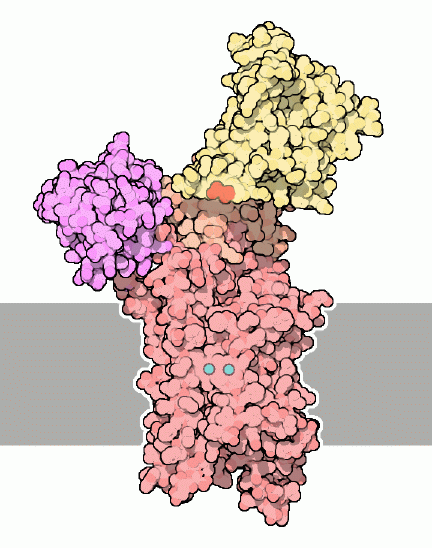|
Inhaltsübersicht | Nanomaschinen | Moleküle | Programme | Kurse | Fun | Links |
||
| > |
The Calcium Pump

The Calcium Pump
Every time we move a muscle, it requires the combined action of trillions of myosin motors. Our muscle cells use calcium ions to coordinate this massive molecular effort. When a muscle cell is given the signal to contract from its associated nerves, it releases a flood of calcium ions from a special intracellular container, the sarcoplasmic reticulum, that surrounds the bundles of actin and myosin filaments. The calcium ions rapidly spread and bind to tropomyosins on the actin filaments. They shift shape slightly and allow myosin to bind and begin climbing up the filament. These trillions of myosin motors will continue climbing, contracting the muscle, until the calcium is removed.Relaxation
The calcium pump allows muscles to relax after this frenzied wave of calcium-induced contraction. The pump is found in the membrane of the sarcoplasmic reticulum. In some cases, it is so plentiful that it may make up 90% of the protein there. Powered by ATP, it pumps calcium ions back into the sarcoplasmic reticulum, reducing the calcium level around the actin and myosin filaments and allowing the muscle to relax. Calcium ions are also used for signaling inside other cells, and similar pumps are found in the cell membrane of most cells. They constantly work to reduce the amount of calcium to very low levels, preparing the cell. Then, at a moment's notice, the cell can allow a flood of calcium to enter, spreading the signal to all corners.Pumping Calcium
The calcium pump is an amazing machine with several moving parts. It is found in the membrane, as shown here from PDB entry 1eul. It has a big domain poking out on the outside of the sarcoplasmic reticulum, and a region that is embedded in the membrane, forming a tunnel to the other side. For each ATP broken, it transfers two calcium ions (shown here in blue) through the membrane, and two or three hydrogen ions back in the opposite direction. As shown on the next page, the calcium pump bends and flexes during the pumping cycle.Next: The Pumping Cycle
Last changed by: A.Honegger,